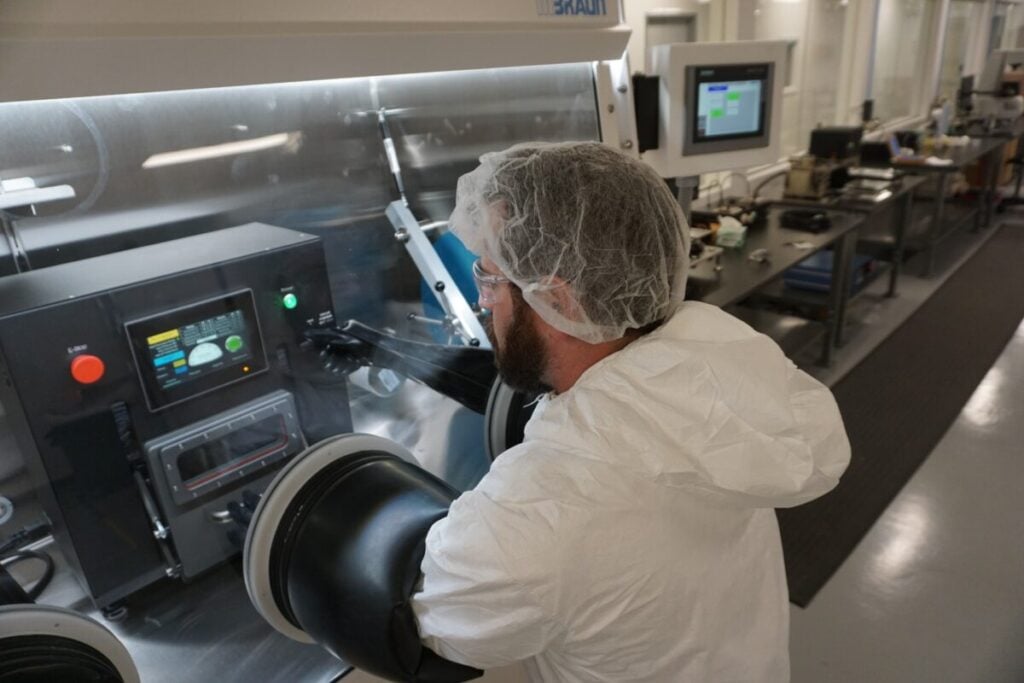
Peak Energy president and CCO Cameron Dales speaks with Energy-Storage.news about the US startup’s plans for scaling sodium-ion battery storage and cell manufacturing, sodium-ion’s advantages, and the bankability of the technology.
US-based sodium-ion battery energy storage system (BESS) startup Peak Energy recently opened its battery cell engineering centre in Broomfield, Colorado.
Enjoy 12 months of exclusive analysis
- Regular insight and analysis of the industry’s biggest developments
- In-depth interviews with the industry’s leading figures
- Annual digital subscription to the PV Tech Power journal
- Discounts on Solar Media’s portfolio of events, in-person and virtual
The announcement comes amidst a trend of sodium-ion related news, such as a BYD executive announcing the launch of a sodium-ion BESS product, Chinese and US firms announcing plans for sodium-ion gigafactories, and the world’s largest sodium-ion BESS coming online in China. Sodium-ion battery technology is widely seen as the next to commercialise at scale and provide an alternative to lithium-ion.
Energy-Storage.news: Does Peak Energy at this time have plans to produce cells at the centre, or is the focus going to be on integrating and testing with third-party cells?
Cameron Dales: The centre is not designed to be a production facility. The plan of the company is to scale up a sodium-ion battery in the US. We’re well along the planning stages of that. It’s a three-phase approach to reaching scale.
First, purchasing sodium-ion cells, integrating them into our own ESS solution. We’re piloting 3.5MWh systems next year as part of our Peak pilot program in Colorado. There are six of the largest IPP and utility customers in the US who are participating in the program. Then, leading to deployment of those systems at customer sites starting in 2026.
Phase two is happening in parallel, which is transitioning to our in-house cell manufacturing, making relatively standard sodium-ion cells, but domestically. That’s a fully IRA compliant domestic content cell factory in the US. Stay tuned for announcements about that.
Phase three, we’re starting the investments now, moving to the next generation of sodium-ion technology. That is what the engineering centre is about. It is getting to the next generation of sodium-ion capability. There are R&D investments we are making on our own with our scientific capabilities. The broader strategy is to work with an entire ecosystem of R&D partners to integrate the best of what can be produced.
We want to be the scale-up partner of choice to bring the technology to market.
What scale of production and demand do you think will be required to be profitable in sodium-ion?
The beauty of the ESS space, particularly in the current environment is that there is a combination of an extremely robust deployment pipeline. In the electric vehicle market, you need to start with a minimum capacity of 30-50 gigawatt hours just to be able to support automotive programs at the volumes they need.
The ESS space allows for companies to scale their way into the market. Sodium-ion provides a different set of performance and safety aspects, most of which are all positive relative to LFP and lithium-ion.
The one downside is at the cell level, it can be lower energy density than lithium-ion. But essentially all other factors are better for this application. Whether its thermal runaway, safety propagation, the environmental footprint of manufacturing cells and materials, the round-trip efficiency, cycle life, these are all significantly better than LFP, even today.
From a scale perspective, we believe that economics can support a profitable business even at a gigawatt hour or less at the cell assembly level. It relies on the continuing growth of the overall material supply chain. That’s not something one company alone can drive to the point where it becomes cost advantageous to LFP.
We have seen an accelerating industry in China for a couple of years due to some of the policy incentives placed for non-lithium technologies. We’re riding that wave as an industry.
How will sodium-ion battery manufacturers prove the bankability of their products?
Folks like Robin Zeng at [the world’s largest lithium-ion battery manufacturer] CATL believe that sodium will take more market share from lithium-ion, even in the EV space. But it’s ready today with a highly competitive performance and cost envelope for stationary storage.
The reason sodium-ion is emerging from the lab today is because the storage market has now reached such a large size over the last two years and it’s growing at more than 25%, justifying investing in commercialisation of this technology.
The idea behind our pilot program is rather than doing multiple one-off pilots with utilities, we are aggregating a consortium model of interested parties that believe this technology is the next generation of ESS storage. In 2026, we move at a smaller scale with them into our first deployed project.
Those double-digit MWh projects lead to 100 plus GWh projects that we start scaling in 2027 and 2028. Those ’27-’28 deployments are based on our own domestic cell manufacturing capability.
What sort of energy density does Peak Energy think can be achieved with sodium-ion?
Someone recently said that sodium-ion is basically where LFP was five-seven years ago. I think that from an energy density perspective, that’s quite true. Sodium-ion is right at the beginning of a rapid energy density improvement curve using essentially the same playbook that brought LFP to arguably the most dominant chemistry in the world.
We see a crossover point coming here in the next probably two to three years, where sodium-ion becomes more competitive on cost than LFP at the system level. When that happens, I think there will be an accelerating shift in market share between sodium and lithium-ion. We are positioning Peak Energy to be at the forefront of that trend.

